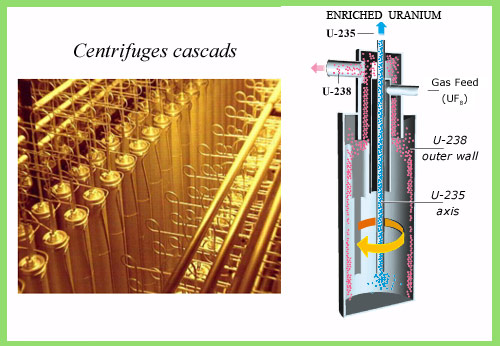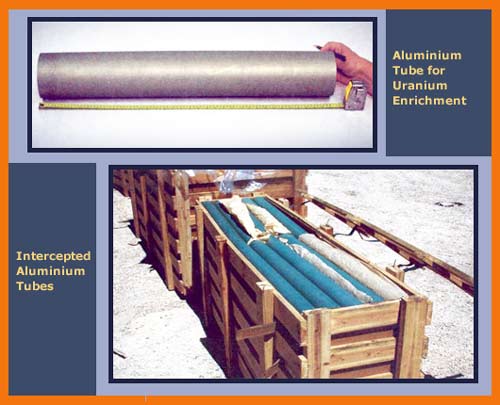Centrifuging and enriching uranium 235
Taking the uranium pathway towards proliferation, the key technology is the development of centrifuges. The goal is to split into a gaseous compound of natural uranium – hexafluoride – the atoms of uranium-235 from the overwhelming majority of isotope 238 atoms which are barely – 1.5% – heavier.

Principles of ultracentrifugiation
Uranium hexafluoride (UF6) gas is injected into a centrifuge spinning at twice the speed of sound. The heaviest isotope, uranium 238, is pushed against the outer wall of the cylinder while the lightest uranium 235, stays closer to the axis of rotation. This uranium compound must pass through several thousand centrifuges before it is enriched to the required percentage. These procedures can, of course, be misappropriated to manufacture atomic bombs.
© IN2P3/Urenco
The centrifuging technique consists of placing this gaseous compound in a cylinder spinning at extreme speeds. The heaviest atoms (of uranium 238) tends to move towards the outer wall of the container, whereas the lighter atoms (of uranium 235) will stay nearer the axis. These are then extracted and sent to another centrifuge, where the same procedure is repeated. In order to obtain weapons-grade uranium, the gaseous compound must pass through tens of thousands of centrifuges before it is enriched to the required standard
This procedure can easily lend itself to nuclear proliferation, as the equipment involved is easy to transport and the energy requirements are minimal.
These centrifuges, however, are not easy to manufacture. The rotors need to be made of specially resistant materials to allow them to rotate at speeds greater than the speed of sound.
The uranium pathway came to public attention during the 2003 Iraqi crisis, when the American secretary of state assured the UN Security Council that Iraq had aluminum tubes which could be used to make centrifuges. Inquiries conducted after the war, however, revealed that the quality of these tubes was too low to be used for nuclear centrifugation. In fact, the bombing of the Osirak reactor in 1981, the 1991 Gulf War, decades of economic and political sanctions, as well as Saddam Hussein’s systematic execution of the scientific elite had totally destroyed the Iraqi nuclear programme.
All the member states of the nuclear club used the uranium and plutonium pathways to manufacture their own atomic bombs. The first military nuclear factory in France was built in Pierrelatte in 1958, under the disapproving eyes of the United States and the United Kingdom, both eager to limit membership to their exclusive club.

Suspicious tubes ?
These aluminum were tubes found by external inspection agencies in Iraq. Were they destined for making bombs? Could they have been used, as the CIA claimed, to make centrifuges? These images were presented to the UN General Assembly on the 5th of February 2003 by Colin Powell, the American Secretary of State at the time. The IAEA’s report, however, concluded later on to the absence of an active nuclear programme. The American investigations conducted after the war reached a similar conclusion.
© Source U.S. State Department
After China and India, Pakistan became the next country to acquire nuclear capabilities. After its Indian rival developed the atomic bomb in 1974, Pakistan was desperate to match this advance. In 1977, a young engineer by the name of Quader Khan returned to the country with secret blueprints of the Urenco centrifuges under his arm. After building an enrichment plant in 1984, it took Pakistan fourteen years to develop the bomb. As the United States needed Pakistani help in supporting the Afghan rebels against the Soviets, the Americans conveniently looked in the other direction.
Quader Khan was made a general in his home country and quickly became a national hero. His influence was also felt outside Pakistan, however, as he helped develop both the Iranian and North Korean nuclear programmes. Pakistan quickly became responsible for a thriving black market in centrifuge technologies, and in 1993 gave nuclear engineering secrets to North Korea in exchange for missiles. The American embargo on Iran prevented them from buying reactor fuel, so they instead invested in enrichment techniques supplied by Pakistan. Libya was also a client.
NEXT : The plutonium way
Other articles on the subject « Nuclear Proliferation »
The plutonium pathway
Extracting weapon-grade plutonium from spent fuel For the plutonium pathway, the key technology i[...]
Iranian Centrifuges
Technical Challenges: IR-1 and IR-2 Centrifuges Uranium enrichment requires significant technical[...]
North Korea
A country cut off from the world that blows hot and cold… The Democratic People’s Rep[...]